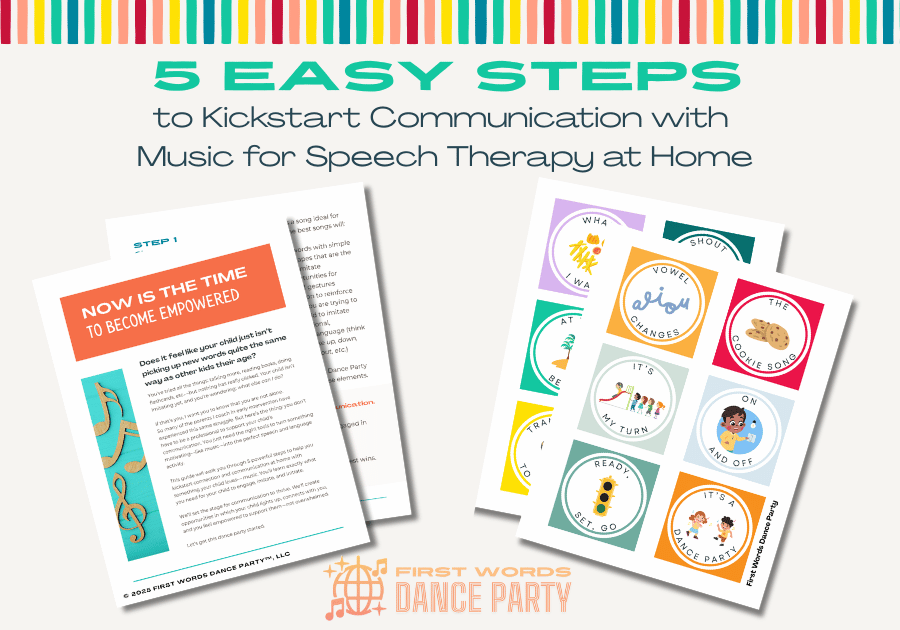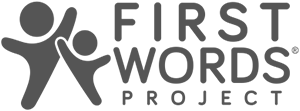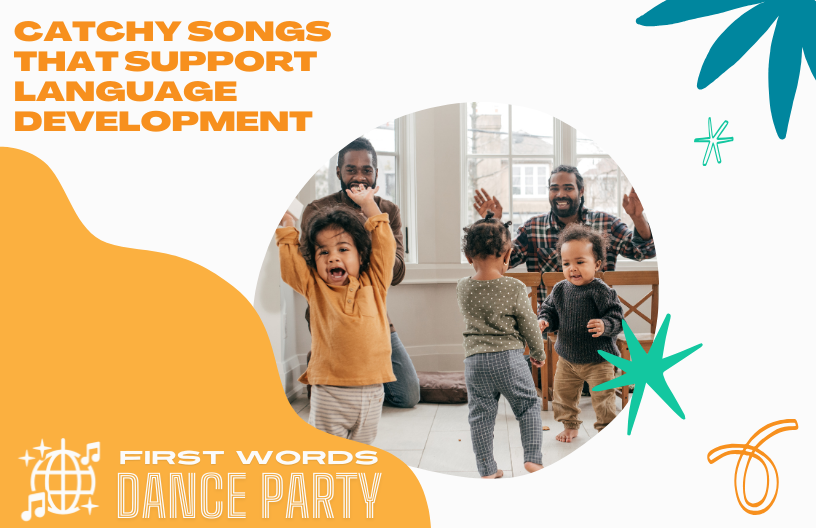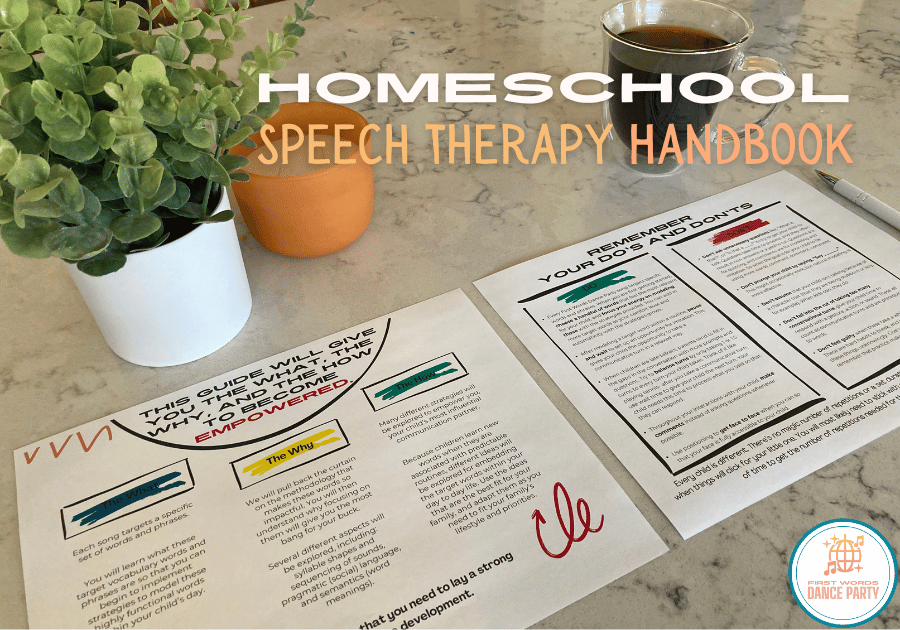Delay in Speech? 5 Easy and Effective Ways to Boost Language
- 0 comments
Are you the parent of a child with a delay in speech? If so, you may be wondering what you can do to get your little one talking at home.
Parenting is, without a doubt, the hardest job we could ever have. When a child has a speech delay, we are challenged in new and unexpected ways- and it can be overwhelming.
The best thing that parents can do for children with a delay in speech is to create language-rich environments with plenty of opportunities for communication. This article will walk you through easy but effective ways to immerse your child in the language they need to start talking
If your child isn’t using many words yet, you may be unsure of what to do and what not to do- and you’re not alone. Many parents I coach in early intervention feel stuck, frustrated, or overwhelmed when their child won’t imitate their words.
That’s why I started creating music for speech therapy that weaves in the strategies we use everyday in early intervention.
You can download a free guide to discover 5 easy, parent-friendly steps to use songs for speech therapy to spark connection and communication with your child. As a bonus, you’ll receive song boards with cards for every First Words Dance Party™ song, so your child can make choices and initiate.
The first step parents should take when they notice a delay in speaking
As an early intervention teacher, I often begin coaching the parents of little ones with a delay in speech when the child is about 18 months old. This is the perfect time to intervene and get the child talking.
Parents of children with speech delays are often surprised to learn that the very first step to take actually isn’t to change how the child communicates.
Instead, the first step is to change how the parent communicates. And we do this by creating an environment filled with the right language models for the child.
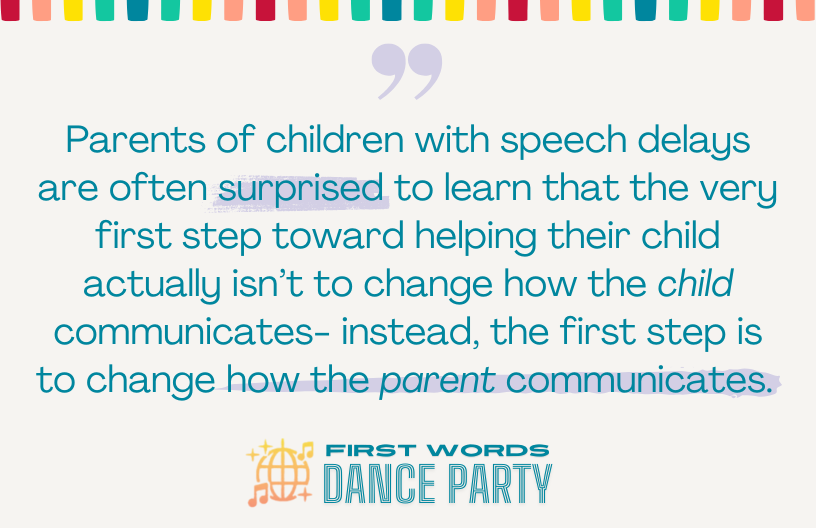
It’s not your fault if your child has a speech delay
Before going further, I want to stress that it is not your fault if your child is demonstrating a delay in talking.
Children can be speech delayed for many different reasons, none of which are due to something you did or didn’t do.
When we talk about creating a language-rich environment, this doesn’t mean that the way that you have been talking to your child up to this point is wrong. It just means that there are other ways that you can communicate with your child throughout the day that are more likely to facilitate language.
So, put any feelings of guilt behind you, and read on to discover what those strategies are.
Read this if you’re wondering how to get a toddler to talk
By now, you’ve probably learned that you just can’t make your child talk. In fact, the more we prompt a child with a speech delay to say something, the quieter and more frustrated they tend to get.
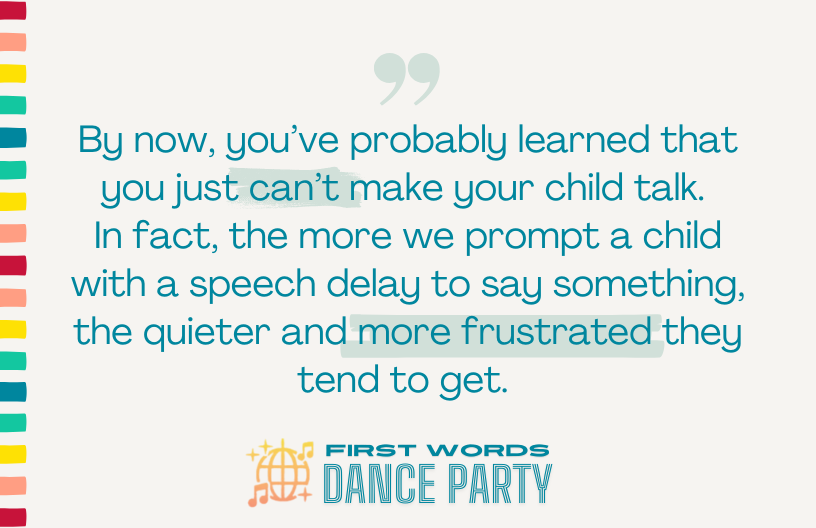
It can be helpful to decrease the pressure on your child. You can do this by using a couple of very powerful, indirect strategies to model the words you’d like your child to say during the activities your child enjoys most.
Use Parallel Talk
Parallel talk means describing and narrating what your child is doing. Pick something your child enjoys- bathtime, playing with cars, or climbing the playground structure at the park.
Use simple words and short phrases to describe what your child is doing. Keep it short and sweet, and don’t be afraid about being repetitive.
Repetition is how little ones learn.
Use Self-Talk
Self-talk is just like parallel talk, except that you’ll be describing what you’re doing. This is a great time to model verbs, or action words, while you make breakfast or while your child watches as you do laundry.
Again, use short phrases to label what you are doing in the moment.
An added benefit to using self-talk and parallel talk is that these strategies help to boost receptive language as well as speech. That's a win-win!
Focus on highly motivating activities with kids delayed in speech
When I’m first starting out with the parents of toddlers, we spend a good amount of time going over what kinds of activities, people, and toys/objects their child enjoys.
The reason for this is to figure out how to add more opportunities for communication into the things that motivate the child most.
The simple strategy of intentionally modeling language during the activities that are most motivating for your child is a powerful technique.
This is because your child is more primed to process and imitate language when they are highly engaged in something.

How to offer more language-rich experiences for toddlers with a speaking delay
Children learn language best when another person models a word naturally. They pick up new words when they can see and experience the object, person, or action within the context of a meaningful activity.
So, for example, a child is much more likely to say, “Daddy” when daddy is actively playing hide-and-seek with the child, versus trying to practice the word “daddy” when dad isn’t there at that moment, interacting with the child.
Here are some ways to model language more effectively to get the most bang for your buck.
Use books, photos, and pictures to provide visuals for children with speech delays
Remember how we used short phrases of only a few words in parallel talk and self-talk? Try using this same approach while looking at books.
This works especially well for little ones who aren’t yet sitting through a whole book.
Try focusing on the pictures in the book instead of the written text. Name the pictures and describe what is happening in the book with short, simple, words and phrases.
Pro tip: Is your child saying the names of family members? Try pointing to and naming family members on framed pictures on the wall, or even on your phone.
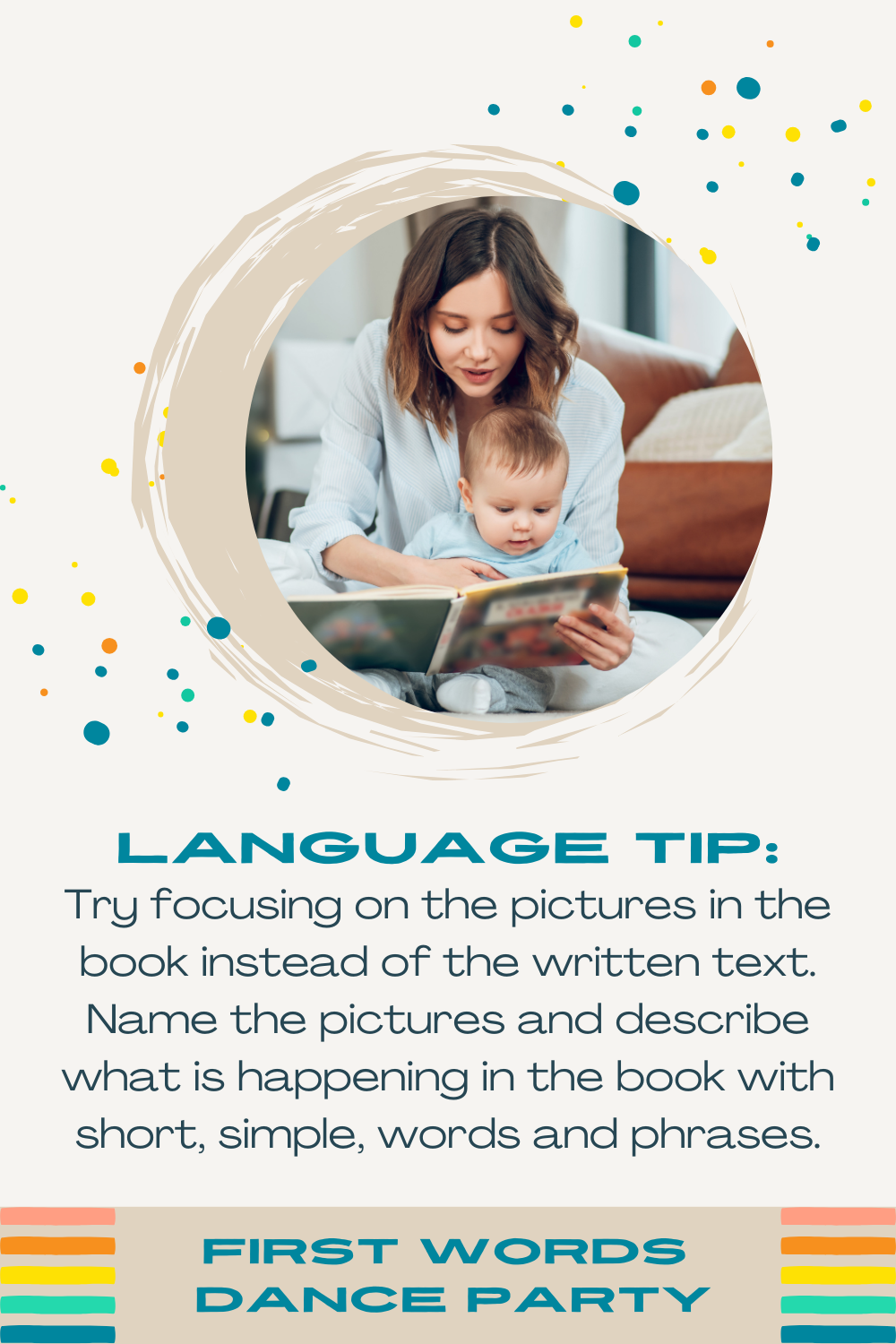
Here's another pro tip: using visuals works wonders to decrease challenging behaviors that are common among children with speech delays. To learn more about what those behaviors are and what you can do to solve the problem, you can read this post.
Sing songs with little ones who demonstrate a delay in talking
Have you tried singing songs with your child? Songs are incredibly powerful because they are predictable, motivating, and repetitive.
Yes, your child can watch all kinds of songs on your phone or on the TV- but this just won’t have the same effect on expanding your child’s ability to talk as it will when you sing with them.
When you sing with your child, they can see how you are producing the sounds within the words and sequencing them together.
You can slow down and repeat the parts your child likes the most. You can use your hands to gesture and do actions.
You can incorporate toys or books you already have- like taking puzzle pieces from your farm puzzle or animals from your barn set when singing Old McDonald.
Common reasons for why parents may not sing when there is a delay in speech
Sometimes parents share with me that they can’t remember the words to songs, or that they don’t sing very well.
Sometimes parents share that it feels a little uncomfortable to sing because singing wasn’t a part of their family culture when they were children.
And all of these things are OK, my friends. There’s no shame in the parenting game.

It is completely normal to feel awkward singing. Just know that, when you do step out of your comfort zone and sing with your child, you are doing wonders for their speech and language development.
Model language as you play with open-ended toys
It isn’t uncommon for little ones to need adults to show them how to play when they are speech delayed. This is especially true once infants turn into toddlers and are past the cause-and-effect stage.
Lots of toys claim to be educational or learning toys, because they sing the ABCs or say the names of colors and shapes.
But ultimately, these toys really don’t do much to help with speech.
How to choose the best toys for language development
Here’s a pro tip to remember when you select toys for your child: the more the toy does, the less there is for your child to do. And the less your child does, the fewer opportunities there are for language.
To put it another way, the more your child can do with a toy, the more opportunities there are for speech and language.
That’s why teachers and speech-language pathologists love open-ended toys that allow for flexibility and endless opportunities for interaction.
Some of my favorites include: Mr. Potato Head™, baby dolls and their accessories, kitchens and play food, blocks, construction toys like Duplos™ or Magnetiles™, ballplay, animal sets, and any Little People™ or other character type toys.
Try to carve out a few minutes in your day when you have some downtime. Get down to your child’s level and show them how to play with the toy.
Throw in those short, repetitive 1-3 word phrases to label what you and your child are doing, and bam. You’re killing it!
More ideas to answer your question of how to teach toddlers to speak
If you’re not sure if your child is demonstrating a speaking delay, or if you’re looking for a way to quickly screen your child in the comfort of your home for free, then the resources available through the First Words Project are a great place to start.
You’ll find tons of printable resources for your child’s specific age in months, along with access to webinars, free social communication checkups, and all kinds of other free goodies.
The American Speech-Language-Hearing Association (ASHA) offers a beautiful, free toolkit titled: Communicating With Baby: Tips and Milestones From Birth to Age 5. These handouts are also specific to age, and include practical ideas to support your child.
When you are a parent raising a young child in the digital age, it can be hard to strike a balance with screentime. ASHA teamed up with the Screen Time Action Network at Fairplay to create Be Tech Wise with Toddler, available in both English and Spanish.
This handout covers daily activities that help parents and caregivers boost their child’s brain, communication, and social–emotional development.
It offers official screen time recommendations from the American Academy of Pediatrics, as well as tips and advice for creating a healthy technology environment in the home.
Strategies for kids with a delay in speech who are music lovers
Does your child love music?
First Words Dance Party capitalizes on the motivational nature of music with songs for speech therapy that model highly functional words with the earliest developing sounds and syllable shapes.
First Words Dance Party brings speech therapy and music together with fun, catchy songs that are just as enjoyable for adults as they are for children. This makes it possible for you to help your child with their expressive and receptive language development anytime you listen and sing along.
Songs for speech therapy everyone can enjoy
These original songs provide functional words and phrases that are perfect for imitation:
Here are a few examples:
The Cookie Song: What first seems like a cute song about every kid’s favorite dessert is actually a dance-y little number that targets the first words yes, no, eat, mommy, daddy, doggie, and of course… cookie! This one is perfect for kiddos who aren’t yet saying “yes” and “no”.
It's My Turn: Another fan favorite. This fun song about sharing helps toddlers and children with speech delays learn the words necessary to ask others for a turn.
“Ready, Set, Go”: A super fun little number that draws on a powerful strategy to build anticipation. Check out the core word lyrics video below to see how this tiny but mighty word in action.
You can stream First Words Dance Party on Spotify, YouTube Music, Apple Music, and anywhere else you get your music.
How to extend the magic from the songs to your child's daily routines
If you’ve ever felt the weight of trying to support your child’s speech progress at home—wondering “Where do I even start?” or feeling like the things you have tried just haven’t been successful—you’re absolutely not alone. Trying to navigate speech therapy home activities that feel meaningful and manageable (rather than another exhausting to‑do) can leave you drained, second‑guessing, and wishing for something simpler.
That’s where the Homeschool Speech Therapy Handbook comes in. Designed specifically for parents (not trained therapists) who want real‑life tools, this guide breaks down exactly what to do, why it works, and how to bring speech‑therapy practice into everyday moments—snack time, bath time, play time—without turning your home into a clinic.
Framed within a song-by-song breakdown of the Speak up and Dance album, you’ll discover how to apply the strategies within each song to real life for easy speech therapy practice at home. You’ll move from feeling overwhelmed and unsure to feeling confident and connected—watching your child engage, communicate, and grow in ways that feel easy and natural.
Final Thoughts
It can feel overwhelming when your child seems to be demonstrating a delay in speaking.
It can feel frustrating when you ask a question or say something to your child and they don’t respond. But just by reading this article, you are showing that you are the exact parent your child needs.
You can help your child to start talking by using a few powerful techniques to create a language-rich environment.
If you're ready to help your child start communicating by tapping into the power of music, then don't forget to grab your free download: 5 Easy Steps to Kickstart Communication with Music for Speech Therapy at Home.
Parents are a child's most influential communication partners. No one is better suited than you to help your child with their communication. This step-by-step guide will spark connection and communication for you and your little one.
I hope that the tips in this article have given you some practical ideas that you can use to create a language-rich environment.
Having a child with a delay in speech can be stressful, but with the right tools in your toolbelt, you’ve got this!
